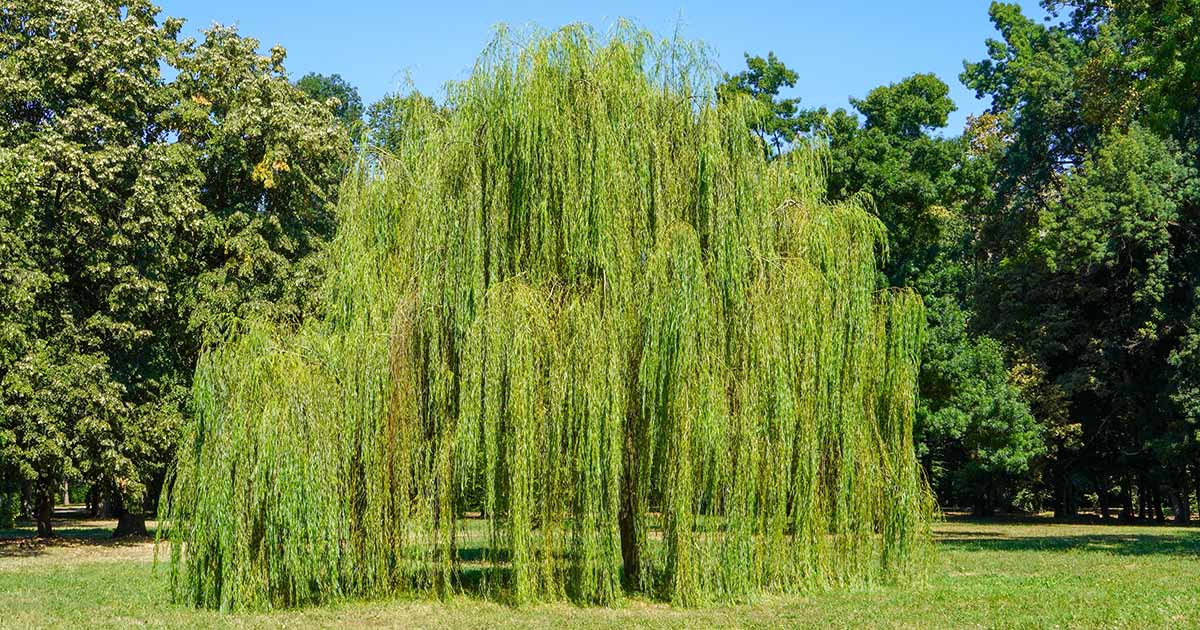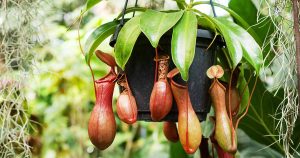
1. Austree
Bred in New Zealand, Salix x ‘Austree,’ is a tall and narrow cultivated hybrid cross between S. babylonica var. matsudana and S. alba.
It features lush green foliage and is best suited to growing as privacy and wind screens. ‘Austree’ is exceptionally tolerant of a variety of soil types and cold weather conditions.
Expect mature heights of 35 to 45 feet with a spread of five to 10 feet, but its height can be kept in check with regular pruning. Provide full sun to part shade in Zones 4 to 9.
This hybrid is available from Fast Growing Trees.
2. Corkscrew
Corkscrew or curly willow, S. babylonica var. matsudana, (syn. Salix babylonica var. pekinensis, S. matsudana) is native to China and Korea and has unique characteristics that make it a landscape focal point.
Twisting branches and twisting, serrated leaves create a texturally rich delight. Yellow autumn foliage and bare yellow winter branches make this a specimen for all seasons.
Expect a mature height of 20 to 30 feet with a spread of 15 to 30 feet. Provide full sun to part shade in Zones 4 to 8.
Corkscrew is available from Fast Growing Trees in a variety of sizes.
3. Dappled
Dappled aka tri-color or coyote willow, S. integra ‘Hakuro Nishiki,’ brings variegated hues to the outdoor living space in an upright, rounded form.
Green foliage dappled with white emerges with a pinkish hue in the spring. Red fall foliage and winter branches make for a glorious year-round display.
S. integra is native to China, Japan, Korea, North America, and Siberia. Mature heights are seven to 10 feet with a spread of four to six feet.
This cultivar prefers full sun in Zones 4 to 9 and exhibits above-average drought tolerance once established.
Dappled is available from Nature Hills Nursery.
4. Flame
Salix alba ‘Flame,’ is a cultivated variety of the white willow which is native to Asia, Europe, and northern Africa.
It is an upright, multi-stemmed cultivar with dense branching suited to use as a privacy screen or windbreak.
Yellow leaves blaze in the fall, followed by striking orange-red winter stems. This type does not produce catkins.
Trees mature to 18 to 20 feet tall and five to 15 feet wide. Choose a full sun to part shade placement in Zones 4 to 9.
‘Flame’ is available from Nature Hills Nursery in #3 containers.
5. Golden Curls
‘Golden Curls’ has twisting bronze branches and curly, long leaves that dangle downward, rippling gracefully in the breeze and shading to yellow in the fall.
Showcase this delicate and whimsical cultivar as a standalone specimen.
This cultivar is a hybrid of the corkscrew type, S. babylonica var. matsudana, and the golden weeping willow, S. alba ‘Tristis.’
Expect mature dimensions of 20 to 30 feet tall and 15 to 20 feet wide. Provide full sun in Zones 4 to 8.
Golden Curls is available from Nature Hills Nursery.
6. Missouri
Missouri, S. eriocephala, aka Missouri River or heart-leaved willow, is a multi-stemmed shrub or tree with green twigs and rich green foliage. Yellow catkins in spring attract local bees.
It’s native to the United States and Canada. Plant singly or in groups for bird and pollinator habitat.
This native species is a compact plant of moderate height, topping out at eight to 12 feet tall and eight to 10 feet wide. It performs well in a full sun location in Zones 5 to 9.
You can find plants available from Nature Hills Nursery.
7. Prairie
Prairie willow, S. humilis, is a North American native multi-stemmed tree or shrub with green foliage that sports slightly ruffled margins.
Small white catkins attract pollinators in the spring. Mass plant for an informal, pollinator-friendly hedgerow.
Mature dimensions are a compact five to 10 feet tall and four to eight feet wide. Grow in full sun in Zones 4 to 6.
Prairie is available from Nature Hills Nursery.
8. Navajo
Navajo, aka globe or Navajo globe willow, S. babylonica var. matsudana ‘Navajo’ makes a substantial focal point with its single trunk and globe-like canopy.
The green foliage has silvery undersides that shimmer playfully in the wind, shading yellow in the fall.
Mature dimensions are an imposing 30 to 50 feet tall and wide. Plant in full sun in Zones 5 to 9.
Globe willow is available from Nature Hills Nursery.
9. Niobe
Niobe golden weeping willow, S. alba ‘Tristis’ is a cultivated variety of the white willow.
It’s a show stopping choice with cascading golden branches that mature to brown. Fine elliptical green foliage shades yellow in the fall.
Expect a mature height of approximately 50 to 60 feet and a spread of 30 to 40 feet. Choose a full-sun to part-shade location in Zones 4 to 8.
Niobe golden weeping is available from Fast Growing Trees.
It is also available from Nature Hills Nursery.
10. Pink Pussy Willow
S. discolor ‘Rosea,’ commonly known as pink pussy willow is a multi-stemmed shrub or small tree with silky soft pink catkins in the spring that bloom on the previous season’s wood.
It’s a cultivated variety of native S. discolor, discussed below.
Prune after flowering for annual armfuls of bud-laden stems for vase arrangements. Growth is upright with a rounded canopy of elliptical green leaves with silvery undersides.
Mature heights are 15 to 25 feet with a spread of 15 to 20 feet. Provide full sun in Zones 4 to 9.
Pink pussy willow is available from Nature Hills Nursery.
11. Pussy Willow
Pussy willow, S. discolor, is a small native tree or multi-stemmed shrub native to the United States and Canada.
It has a rounded canopy and silvery white catkins in the spring. The leaves are elliptical, with green on top and a silver cast below. Grow as a specimen in the cutting garden for an abundance of stems to add to your arrangements.
Mature dimensions are 15 to 25 feet tall and 15 to 20 feet wide. Grow in full sun in Zones 4 to 9.
Plants are available from Nature Hills Nursery.
You can learn more about how to grow pussy willow in our guide.
12. Scarlet Curls
‘Scarlet Curls,’ is a medium-sized upright tree with twisting stems and curling green leaves. It’s a hybrid cross between S. babylonica var. matsudana and S. alba.
The branches offer spectacular colors: red when young and yellow as they age.
Heights are 25 to 30 feet with a spread of 15 to 20 feet. Grow in full sun in Zones 5 to 8.
‘Scarlet Curls’ is available from Nature Hills Nursery.
13. Weeping
Native to China, the weeping willow, S. babylonica, is a large species that displays layer upon layer of slender, arching branches that sway gracefully, adding motion to the landscape.
Fine, lance-like green leaves shade yellow in autumn.
Mature dimensions are 30 to 50 feet tall and wide. Grow in full sun in Zones 4 to 9.
Weeping is available from Fast Growing Trees in a variety of sizes.
Learn more about how to grow weeping willows in our guide.
A Wealth of Willows
With 13 varieties from which to choose, it’s time to take out the garden planner and decide where you’ll grow your tree.
Choose a location with full sun to part shade and moist, sandy loam that drains well.

If your property is near a pond, shoreline, or stream, consider planting one or more types of Salix nearby for easy access to the water they crave.
For inland growing, avoid placements where the roots may interfere with pavements and pipes underground, and consider installing an irrigation system to maintain moisture.
Do you grow willows? Tell us about them in the comments section below.
If you found this article informative and want to learn more about growing willows, we recommend the following guides next:

















